Interview with Dr. Hans E. Mülder, Director Marketing and Senior Audiologist at Phonak Communications, Phonak Headquarters, Switzerland
Carolyn Smaka: Hans Mülder, glad to have you join me today. Phonak has a long history of FM innovation and I’m excited to talk about the latest wireless solution.
Hans Mülder: Thank you. Yes, it was in 1996 that we came out with MicroLink (ML), and it was the first miniaturized, ear-level FM receiver that would couple to different Phonak hearing aids. Then in 2000, we came out with the MLx, and that was the first universal ear-level receiver, which was pretty cool, because we made a decision that we didn’t want our FM systems to just be for Phonak products. We wanted them to be compatible with all the other manufacturers’ hearing aids as well as all the different cochlear implant manufacturers.
Then in 2003, we introduced multifrequency receivers, where you could push a button on the transmitter and change the transmission and reception frequencies. We eliminated the crystals, and with that, we also eliminated a lot of the hassle that you had with maintaining FM systems.
In 2007 we introduced Dynamic FM. That was the very first system where the transmitter would measure the ambient noise in the classroom and transmit information to the receiver and tell the receiver to adjust its gain level, which resulted in a huge boost in speech understanding in noise. It also had many other innovative features at the time like MultiTalker Network. Now, at AudiologyNOW! 2013 we will introduce Roger as the new standard for wireless technology.

Carolyn: Tell me about Roger – what are the benefits and what challenges did you want to address in developing this solution?
Hans: Sure. Roger is based on a new 6.8 million transistor chipset. If you think about it, that is huge compared to a Pentium chip, which has about 5.5 million transistors. It makes use of intelligent and adaptive algorithms that avoid interference and optimize the operating range. Signals are digitized and packaged in very short packets. Then they are broadcast repeatedly at different channels in the 2.4 to 2.4835 GHz frequency range. Roger systems are continuously looking for free channels and automatically adapting. What we’re doing is replacing the frequency management of FM by automatic digital networks between Roger wireless microphones and Roger receivers without using fitting software.
Carolyn: That makes sense, obviously, when you think about schools and classrooms, which are key places where this technology would be used, and you may not have the software readily available to be making changes.
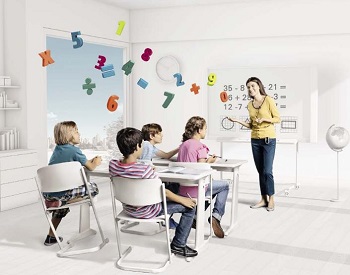
Hans: A lot of children with hearing impairment these days are mainstreamed. But you still do have some self-contained classrooms. When the kids are changing classrooms, you always have to have different frequencies and different allocations of those frequencies in different classrooms with FM or some other digital systems. You would invariably come up with some challenges to get multiple transmitters in different schools.
With Roger, we’re creating a network. You’re connecting Roger microphones to Roger receivers. Networks are created by a simple push of a button on a Roger microphone when it is held close to another Roger device. Both Roger receivers and other Roger microphones can be added to this network at any time. With the optional Roger WallPilot children that enter a classroom are automatically taken into that network, but the Roger WallPilot can also add a second Roger microphone of another teacher to that particular classroom network.
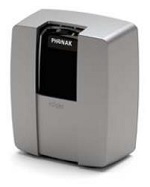
Roger Wall Pilot
Carolyn: Let’s talk about noise, because we know that FM technology has been the best ear-level technology to overcome noise and improve the signal-to-noise ratio. What does Roger bring to the table in terms of overcoming ambient noise?
Hans: Roger’s new adaptive behavior, beam formers and noise cancellers are proven to give hearing instrument and cochlear implant users the best ever speech understanding in noise. Ambient noise is measured very precisely by Roger microphones. Roger receivers adjust their volume accordingly and automatically, especially at higher noise levels, in a much better way than we were able to achieve with Dynamic FM. A typical classroom can be 60 to 80 dB(A). When we see these higher noise levels of 65 to 80 dB, the performance of Roger improves over traditional and even Dynamic FM, systems by 35 to 54 % in speech recognition scores measured with the HINT. It’s not because Roger is digital or because it operates at 2.4 GHz. It’s because of Roger’s new adaptive behavior. We have analyzed mathematically the acoustical parameters, and we are confident to say that more SNR is virtually not possible.
Carolyn: You mentioned that the Roger microphones and the Roger receivers are doing this automatically. So there are no buttons on the system that the teacher or the child has to push or anything like that to engage this adaptive behavior?
Hans: Exactly. It’s all fully automatic.
Carolyn: You mentioned an improvement on the HINT. Can you go in to more detail regarding how you tested this technology prior to bringing it to market?
Hans: Sure – when we developed Roger we had the ambition and also the confidence that it would be significantly better than Dynamic FM. We wanted to know exactly how much better and for that we asked external scientists to investigate this. With Roger, some of the studies were done by Dr. Linda Thibodeau from the University of Texas at Dallas.
She tested it against the benchmark, which is Dynamic FM, and against traditional FM as well. She saw tremendous improvements especially at the 65 to 80 dB noise levels (Figure 1). At 70 dB, she saw about a 35% improvement over Dynamic FM, and at 80 dB she saw more than 50% improvement. As the ambient noise levels increase, you can see the amount of improvement over both Dynamic FM and traditional FM really increases.
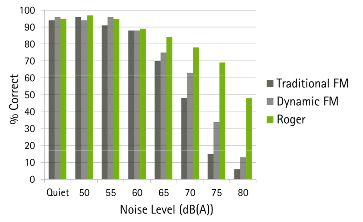
Figure 1. HINT percent-correct scores for hearing aid users as a function of noise level for traditional FM, Dynamic FM and Roger.
Dr. Jace Wolfe at Hearts for Hearing in Oklahoma has also conducted studies with subjects who use cochlear implants. He saw similar results with the different cochlear implant manufacturers. He did studies with Cochlear (Figure 2), Advanced Bionics (Figure 3) and MED-EL.
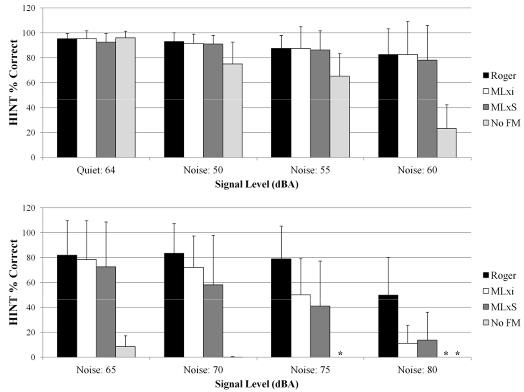
Figure 2. Speech recognition scores using the HINT for the users of Cochlear Nucleus 5 sound processors in quiet, low levels of noise, and higher levels of noise. MLxi is Dynamic FM and MLxS is traditional FM technology.
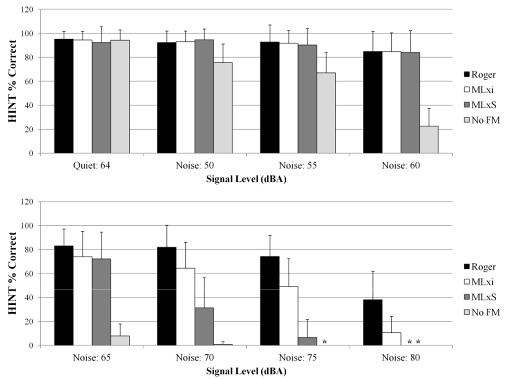
Figure 3. Speech recognition scores using the HINT for the users of Advanced Bionics Harmony sound processors in quiet, low levels of noise, and higher levels of noise. MLxi is Dynamic FM and MLxS is traditional FM technology.
Carolyn: You mentioned Roger is compatible with both hearing instruments and cochlear implants. Can you provide more information about compatibility with all the various systems on the market?
Hans: That’s a very good question, Carolyn. Roger is compatible with all existing hearing aids that have a direct audio input (DAI), or have a T-coil, or have a wireless streaming device with a DAI, as well as all the cochlear implant manufacturers’ processors that are on the market today. The Roger inspiro Premium teacher microphone still can transmit in the 216 to 217 MHz frequency band, which is currently used with Dynamic FM and some other manufacturers of FM, and it can also be used at the same time for students who are using the new Roger technology. It can broadcast in 216 to 217 MHz and 2.4 GHz at the same time, so it doesn’t require school districts to change all at once into a new platform. We have consciously developed a new technology that allows schools to gradually upgrade.
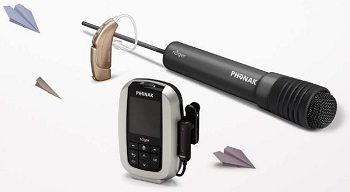
Some of the Roger transmitters and receivers for schools
Carolyn: Will the Roger technology be used in sound field systems also?
Hans: Yes, it will also be used with the Phonak sound field systems, which we will then call Roger Dynamic SoundField. It currently uses 2.4 GHz. That was the beauty of it - we’ve taken that frequency technology and moved it into a personal FM. But the main thing that we’ve done is improved the algorithms, thereby improving the SNR, especially in noisy environments. That’s been the big improvement, but to answer your question, you can use the Roger inspiro Premium with the Roger receivers, the Dynamic FM receivers and the Dynamic SoundField systems all at the same time. I think it’s interesting to mention that when we use 2.4 GHz, we’re really reducing the wavelength. It’s basically down to 12 centimeters, so we’re able to create some very small products. The new universal ear level receiver Roger X is about 35% smaller than our smallest receiver of today and it is by far the smallest universal receiver on the market. But the other question we hear frequently is, “How do we avoid similar nearby systems or other appliances such as Wi-Fi?” Most Wi-Fi systems use 2.4 GHz as well. What we’ve been able to do is create a technology that is looking for free channels (Figure 4). We don’t have to worry too much or be concerned about other systems that are using the same frequencies.
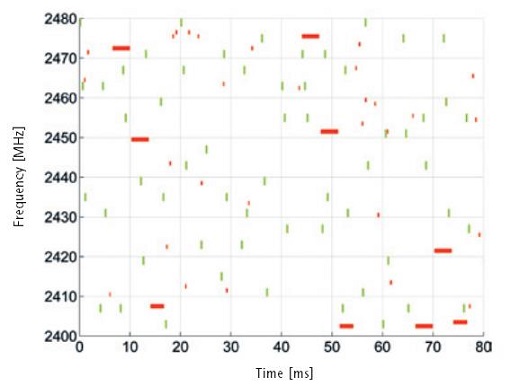
Figure 4. By hopping frequencies and repeated broadcast of audio packets, interference can be minimized.
Carolyn: Would we expect that the Roger technology is going to have significantly more current drain?
Hans: No, not at all. With Bluetooth, you do have high current drain, right? With the Roger technology we’re able to reduce the current drain dramatically compared to other digital systems. We have about the same current drain as the Dynamic FM receivers, so we do not foresee any significant impact.
Carolyn: I have to ask you about the name before we finish up - how did you come up with the name Roger for this technology?
Hans: Well, you hear pilots and military personnel use the word, “Roger” or “Roger that” as an important communication tool, meaning “message received and understood”. This is what it is all about and that’s where the name came from. Roger is the name of the standard, not just one product. We will have Roger transmitters, Roger receivers, and various other Roger products, not just for the hard-of-hearing population, but also for students and adults with attention deficit disorders and learning disabilities who need an improved SNR. FM in audiology has been around for half a century. Roger will not be the flavor of the day, but is here to stay for many years to come.
Carolyn: Thanks for your time on providing us an overview today. I see you have a lot of collateral materials and support available for professionals who would like more information.
Hans: Thank you. We’re very excited about this new standard. Our goal is to provide access in noise so that young children can learn spoken language, and older children have optimal access to learning. A good signal-to-noise ratio is critical. And we are thrilled by the benefits and improvements Roger delivers over current systems.
For more information, please visit https://www.phonakpro.com/ and https://www.phonak.com/ or the Phonak Expo Page on AudiologyOnline.


